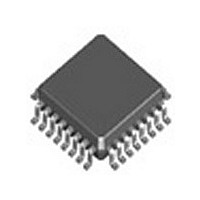DJLXT384LE.B1SE001 Intel, DJLXT384LE.B1SE001 Datasheet - Page 51

DJLXT384LE.B1SE001
Manufacturer Part Number
DJLXT384LE.B1SE001
Description
Manufacturer
Intel
Datasheet
1.DJLXT384LE.B1SE001.pdf
(140 pages)
Specifications of DJLXT384LE.B1SE001
Screening Level
Industrial
Mounting
Surface Mount
Operating Temperature (min)
-40C
Operating Temperature (max)
85C
Lead Free Status / RoHS Status
Not Compliant
- Current page: 51 of 140
- Download datasheet (2Mb)
6.3.7
Document Number: 248994
Revision Number: 005
Revision Date: November 28, 2005
When an LOS condition is detected and the RAISEN bit setting is:
To prevent inadvertent interrupts during programming, before setting or resetting RAISEN, mask
the AIS interrupt enable bit for the corresponding receiver. (See
Register, AISIE - 14h” on page
Receiver In-Service Line-Code-Violation Monitoring
Receiver in-service line-code-violation monitoring occurs only with unipolar I/O (that is, when
TNEG/UBS is connected high for more than 16 consecutive MCLK cycles). In this case, when the
LXT384 Transceiver is receiving a line input signal and an in-service line-code violation occurs,
how this violation is reported depends on the type of decoder selected.
If the LOS Detector circuit (see
service line-code violation and the LXT384 Transceiver decoder type is:
•
•
•
•
•
‘0’, AIS insertion into the receive path is disabled. In this case, there is no effect on the AIS
Status Monitor register.
‘1’, AIS insertion into the receive path is enabled. In this case, when the signals to the RTIP
and RRING inputs to a receiver are:
AMI, all bipolar violations (two consecutive pulses with the same polarity) are reported at the
BPV output.
HDB3, the following occurs:
B8ZS, the following occurs:
— All zeroes, the receiver generates all ones on the RPOS and RNEG outputs, and the AIS
— All ones, the receiver generates all ones on the RPOS and RNEG outputs, and the AIS
— First, the LXT384 Transceiver asserts the BPV pin high for one RCLK period for every
— Next, the RDATA pin acts as the receive data output. (For details on the BPV and RDATA
— The LXT384 Transceiver reports bipolar violations on BPV for one RCLK period, for
— Bipolar 8-zero substitution is an encoding method used on T1 circuits that inserts two
Status Monitor register sets to ‘1’.
Status Monitor register clears to ‘0’.
bipolar violation that is not part of the zero-code substitution rules.
pin functions, see
every B8ZS violation that is not part of the zero code substitution rules.
successive ones of the same voltage—referred to as a bipolar violation—into a signal
whenever eight consecutive zeros are transmitted. The device receiving the signal
interprets the bipolar violation as a timing mark, which keeps the transmitting and
receiving devices synchronized. Ordinarily, when successive ones are transmitted, one has
a positive voltage and the other has a negative voltage.
Section 5.3, “Framer/Mapper
85)
Section 6.3.3, “Receiver Loss-Of-Signal
Intel
®
LXT384 Octal T1/E1/J1 S/H PCM Transceiver with JA
Signals”.)
Table 48, “AIS Interrupt Enable
Detector”) detects an in-
51
Related parts for DJLXT384LE.B1SE001
Image
Part Number
Description
Manufacturer
Datasheet
Request
R

Part Number:
Description:
Microprocessor: Intel Celeron M Processor 320 and Ultra Low Voltage Intel Celeron M Processor at 600MHz
Manufacturer:
Intel Corporation

Part Number:
Description:
Intel 82550 Fast Ethernet Multifunction PCI/CardBus Controller
Manufacturer:
Intel Corporation
Datasheet:

Part Number:
Description:
Intel StrataFlash memory 32 Mbit. Access speed 120 ns
Manufacturer:
Intel Corporation
Datasheet:

Part Number:
Description:
Intel StrataFlash memory 32 Mbit. Access speed 120 ns
Manufacturer:
Intel Corporation
Datasheet:

Part Number:
Description:
Intel StrataFlash memory 64 Mbit. Access speed 150 ns
Manufacturer:
Intel Corporation
Datasheet:

Part Number:
Description:
Intel StrataFlash memory 32 Mbit. Access speed 100 ns
Manufacturer:
Intel Corporation
Datasheet:

Part Number:
Description:
DA28F640J5A-1505 Volt Intel StrataFlash Memory
Manufacturer:
Intel Corporation
Datasheet:

Part Number:
Description:
5 Volt Intel StrataFlash?? Memory
Manufacturer:
Intel Corporation
Datasheet:

Part Number:
Description:
5 Volt Intel StrataFlash?? Memory
Manufacturer:
Intel Corporation

Part Number:
Description:
Intel 6300ESB I/O Controller Hub
Manufacturer:
Intel Corporation
Datasheet:

Part Number:
Description:
Intel 82801DB I/O Controller Hub (ICH4), Pb-Free SLI
Manufacturer:
Intel Corporation
Datasheet:

Part Number:
Description:
Intel 82801FB I/O Controller Hub (ICH6)
Manufacturer:
Intel Corporation
Datasheet:

Part Number:
Description:
Intel Strataflash Memory28F128J3 28F640J3 28F320J3
Manufacturer:
Intel Corporation
Datasheet:











